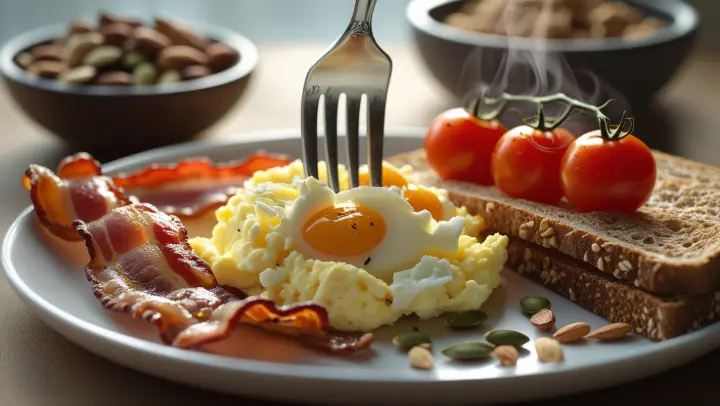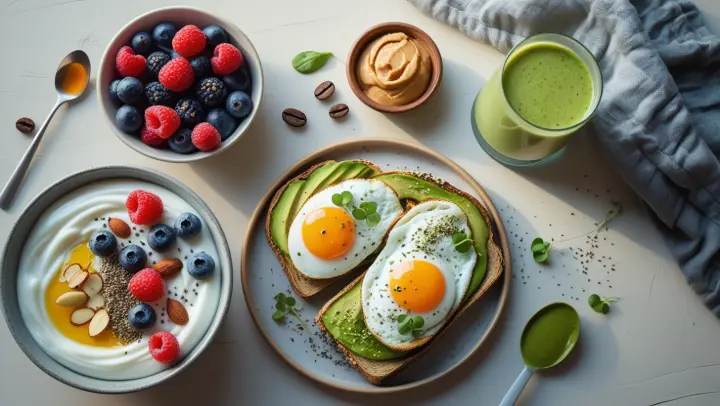The Protein-Powered Morning: Why Your Breakfast Needs a Major Upgrade (And How to Do It)
Let's be honest—most of us have been there. That "breakfast" of sugary cereal, a rushed pastry, or just a sad piece of toast leaves you crashing hard by 10:30 AM, raiding the snack drawer, and wondering why you feel so sluggish. What if the secret to conquering your morning (and maybe your whole day) wasn't more coffee, but a simple shift on your plate? Enter the high-protein breakfast: not just a trend, but a science-backed strategy for sustained energy, better focus, and even managing your weight. Let's dive deep.
Why Protein Deserves the Breakfast Spotlight (It's More Than Just Muscles)
Sure, protein builds muscle. But its magic at breakfast goes way beyond the gym. Here’s the breakdown:
The Satiety Superpower: Protein is the undisputed champion of fullness. Compared to carbs and fats, it takes longer to digest and significantly impacts hormones like ghrelin (the "hunger hormone") and peptide YY (the "fullness hormone"). The result? You feel satisfied longer, reducing those mid-morning cravings and mindless snacking. A study in the American Journal of Clinical Nutrition found that a high-protein breakfast (around 30-40g) led to reduced hunger and significantly lower calorie intake throughout the day compared to a high-carb breakfast of equal calories.
Blood Sugar Stabilizer: Carbs, especially refined ones, cause rapid spikes and crashes in blood sugar. Protein acts like a buffer, slowing down the absorption of carbohydrates eaten alongside it. This means steadier energy levels, improved focus, and avoiding that post-breakfast fog. Dr. David Ludwig, a Harvard endocrinologist, often emphasizes that pairing carbs with protein and fat is key for metabolic health – and breakfast is the perfect place to start.
Metabolic Boost (The Thermic Effect): Your body burns calories just digesting food. Protein has the highest "thermic effect of food" (TEF) – meaning you burn more calories processing protein (20-30% of its calories) than carbs (5-10%) or fats (0-3%). While not a magic weight loss bullet on its own, this metabolic nudge contributes to overall energy expenditure.
Muscle Maintenance & Growth: While intense muscle building happens around workouts, providing your body with consistent protein, including at breakfast, helps maintain muscle mass throughout the day. This is crucial for everyone, not just athletes, as muscle mass supports metabolism, strength, and healthy aging.
How Much Protein Are We Talking About?
The "high" in high-protein breakfast is relative. While individual needs vary based on weight, activity level, and goals, aiming for 20-40 grams of protein is a solid target range for most adults seeking the benefits above. This is significantly more than the 5-10 grams found in a typical bowl of cereal or a bagel.
A hearty breakfast plate featuring creamy scrambled eggs, crispy bacon, vine-steamed tomatoes, and seeded toast. Garnished with seeds and nuts, it's a warm, protein-rich start to the day, captured in rich.

Think of it this way: A single egg has about 6g. One cup of milk has 8g. A small yogurt might have 5-6g. You quickly see how easy it is to fall short without consciously building protein in.
Beyond Bacon & Eggs: A World of High-Protein Breakfast Options (No Boredom Allowed!)
The beauty of a high-protein breakfast is its incredible versatility. Forget the notion that it's just eggs every single day. Let’s explore categories:
The Egg-cellent Foundation:
Versatility: Scrambled, fried, poached, boiled, in omelets or frittatas.
Protein Powerhouse: 2 large eggs = ~12g protein. Boost it further!
Build It: Add veggies (spinach, peppers, mushrooms), lean meats (turkey sausage, ham), or cheese (feta, cottage cheese) to an omelet. Top avocado toast with a fried egg (+ healthy fats!). Hard-boiled eggs are a perfect make-ahead grab-and-go option. Mythbuster: The cholesterol in eggs has a minimal impact on blood cholesterol for most people – focus on the whole package of nutrients!
Greek Yogurt & Skyr: The Creamy Champions:
Protein Punch: Greek yogurt (especially non-fat) packs ~15-20g protein per 3/4 cup! Icelandic Skyr is even denser, often hitting 20g+ per serving.
Build It: Ditch the sugary flavored kinds. Opt for plain and customize:
Sweet: Add berries, a sprinkle of nuts/seeds (chia, flax, almonds), and a touch of honey or maple syrup.
Savory: Mix in herbs (dill, chives), cucumber, everything bagel seasoning, maybe a dollop of hummus. Use it as a base for a breakfast bowl with smoked salmon.
Cottage Cheese Comeback: Don't sleep on cottage cheese! It's having a well-deserved renaissance. 1/2 cup = ~14g protein. Blend it smooth for a ricotta-like texture on toast with fruit and honey, or enjoy it chunky with pineapple, tomatoes, or pepper.
Protein Smoothies: The Ultimate Customizable Fuel:
The Base: Unsweetened milk (dairy or soy have the highest protein – 8g/cup) or a protein-fortified plant milk. Add Greek yogurt or skyr for extra creaminess and protein.
The Booster: A scoop (20-30g) of high-quality protein powder (whey, casein, pea, soy, hemp). Insight: Whey is fast-digesting, casein is slow. Plant blends offer vegan options.
The Extras: Add fruit (berries, banana), veggies (spinach, kale - you won't taste it!), healthy fats (nut butter, avocado, chia/flax seeds), and maybe oats for complex carbs. Example: 1 cup milk (8g) + 1 scoop whey (25g) + 1/2 banana + 1 Tbsp peanut butter = ~35g protein.
Lean Meats & Fish: Savory Power:
Options: Turkey or chicken sausage (check labels for low sodium/saturated fat), lean ham, smoked salmon (lox), leftover grilled chicken or turkey.
Build It: Add a slice or two to whole-grain toast or an English muffin. Fold into scrambled eggs or an omelet. Top avocado toast with smoked salmon and capers. Caveat: Processed meats like bacon and regular sausage should be occasional treats due to sodium and saturated fat.
Plant-Based Powerhouses:
Tofu Scramble: The vegan answer to scrambled eggs! Crumble firm tofu, sauté with turmeric (for color), nutritional yeast (for cheesy flavor/B-vitamins), and veggies. ~15g protein per 1/2 cup tofu.
Legumes: Add black beans or lentils to breakfast burritos or huevos rancheros. Smashed chickpeas with avocado on toast. ~7-10g protein per 1/2 cup.
Seeds & Nuts: Chia pudding (soaked overnight in milk – 4g protein per Tbsp chia + milk protein). Add nuts/seeds liberally to yogurt, oatmeal, or toast (peanut butter on whole wheat = ~8g protein per Tbsp PB + bread protein).
Plant-Based Yogurts & Milks: Opt for soy-based versions for the highest protein (similar to dairy). Almond/coconut/oat yogurts are often very low in protein unless fortified – always check the label!
The Oatmeal Upgrade: Yes, oatmeal can be high-protein!
Cook it in milk instead of water (soy or dairy).
Stir in protein powder after cooking (blends best).
Top generously with Greek yogurt, nuts/seeds, or nut butter.
Use higher-protein grains like quinoa flakes sometimes.
Putting it All Together: Making High-Protein Breakfasts Work for YOU
Plan Ahead: This is key! Hard-boil eggs on Sunday. Pre-portion yogurt toppings. Make chia pudding overnight. Cook a big frittata to slice all week.
Start Small: If you're used to low-protein breakfasts, don't jump to 40g overnight. Aim for 20g consistently first. Add an extra egg or a scoop of yogurt.
Listen to Your Body: Notice how you feel. More energy? Less hungry? Better focus? That’s the proof.
Hydrate: Protein metabolism requires water. Start your day with a glass alongside your breakfast.
Balance is Still Key: While protein is the star, include complex carbs (whole grains, fruit, veggies) for fiber and sustained energy, and healthy fats (avocado, nuts, seeds, olive oil) for satiety and nutrient absorption. A truly balanced plate is the goal.
The Bottom Line: It's a Game-Changer
Switching to a high-protein breakfast isn't about restrictive dieting; it's about strategic fueling. It’s investing the first 15 minutes of your day to set yourself up for success for the next 8 hours. You’re giving your body the signal: "We're awake, we're nourished, and we're ready." You'll likely experience fewer cravings, steadier energy, sharper focus, and potentially find weight management easier.
It doesn't have to be complicated or time-consuming. Find a few options from the list above that you genuinely enjoy, experiment, prepare a little, and experience the difference. Your future self, especially the one at 11 AM, will thank you. Think of it not as changing breakfast, but as upgrading your entire morning – and maybe your whole day. That's a tiny daily revolution worth making.
High Protein Breakfast
A fresh and healthy breakfast spread featuring avocado toast with eggs, Greek yogurt topped with berries and nuts, a bowl of mixed berries, nut butter, and a green smoothie. Beautifully styled with natural lighting for a clean, nutritious start to the day.
